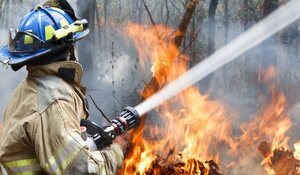Getting water flow right is a crucial component when fighting fires, and it’s the key responsibility of the pump operator. However, determining the pump discharge pressure for each line requires the operator to know the gallons per minute (gpm) flow, which will be determined by the selected nozzle. Then the hose size and length must be taken into account, along with any appliances or gates that would affect flow.

Finally, the pump operator can calculate the friction loss in fire hoses, which helps them to deliver water at the right flow rate and pressure for the crew to fight the fire safely and effectively. But what is fire hose friction loss, and how do you calculate it?
Friction Loss in Fire Hoses
Friction loss in fire hoses is the effect of the resistance of water against the inside of the fire hose, resulting in a drop in pressure at the terminal end. Friction loss is also present in pipes and hose fittings as well.
What causes friction loss in fire hoses can be influenced by many factors:
- Age of hose
- Length of hose
- Hose type, weave, and quality
- Hose lining
- Water flow (gpm)
- Water turbulence
- Gravity
According to the National Wildfire Coordinating Group¹, friction loss is quadrupled every time flow is doubled. Relatedly, increasing hose size decreases the friction loss, as the fifth power of the hose diameter².
When the pump operator knows the friction loss, they can adjust the pump discharge pressure, thereby producing the desired nozzle pressure.
How to Calculate Friction Loss in Fire Hose
The fire hose pressure calculator uses mathematical formulas to calculate friction loss in fire hoses. Use this as a fire hose friction loss cheat sheet.
A common firefighter friction loss formula is this:
FL = C * (Q / 100) ^2 * L / 100
Where FL = Friction Loss in PSI, C = friction loss Coefficient (or friction loss factor), Q = Flow rate in GPM, and L = hose Length.
Generally, C is understood to be a constant that combines hose diameter and roughness, but it is not a precise measurement³, as diameter and roughness can affect flow differently. That’s why published data doesn’t always match up to verified flow meter testing. You can see C constants in data from the National Fire Protection Association.
Note: The Fire Protection Research Foundation⁴ and others believe that standard rules of thumb regarding fire hose friction loss calculations may be too conservative, as they are based on dated hose technology. Advancements in hose fabrication have reduced friction loss, and using outdated calculations could cause excessively high pump discharge pressures.
However, friction loss tables are still useful as a starting point for friction loss calculations. The tables typically show gpm on one axis and hose diameter (100 ft) on the other.
You can access fire hose friction loss charts or cheat sheets⁵ for the most common hose sizes. These will give you the FL for a certain gpm measurement, which you can then use in calculating pump discharge pressure.
Another Method
It should be said that calculating friction losses using a mathematical formula is not always the best way to operate on a fire scene, when time is of the essence.
In the field, it’s more helpful to understand how to figure out fire hose friction loss without resorting to paper and pencil. You can simplify your calculations and still arrive⁶ at a working pump discharge pressure suitable to the situation at hand. It will help you to memorize the most common nozzle sizes and configurations you are likely to encounter with your department.
The Hand Method
When you know hose size and gpm, you can use what’s known as the Hand Method to arrive at a rough estimate of friction loss. The Hand Method⁷ requires you to memorize the gpm for your nozzle (fog or smooth bore). It’s not your standard friction loss formula, but it still gets the job done.
Assign each gpm setting to a finger: 95 gpm to your thumb, 125 gpm for your index, 150 gpm for middle, 175 gpm for ring finger and 200 gpm for your pinkie.
Number each finger, 1 through five, starting with your thumb.
Finally, imagine 12 at your palm (for 1 ¾” hose). When you need to calculate friction loss, find your desired gpm and multiply by 12. If you need 125 gpm on 100 feet of hose, that corresponds to number 2 on your finger. Multiply 2 by 12 to get 24; your friction loss is 24 psi. (You can double check this technique using a friction loss table.
The hand method is not precise, but it will get you close to where you need to be when a fire is blazing.
Avoiding Fire Hose Friction Loss
While friction loss is a fact of life when fighting fires, there are ways to reduce it. Here are several methods for reducing friction loss in fire hose.
Fire Hose Maintenance
The first, and easiest, method for reducing friction loss in fire hoses is to ensure the upkeep and maintenance of your hose and equipment. Since rough hose increases friction loss, keeping hose (and other equipment) in good working order reduces that effect.
Store and transport your fire hose with care. Avoid kinks and make sure there is plenty of air circulation. Keep it clean after coming into contact with dirt, oil, and chemicals, and protect the outer jacket from abrasions. Also, make sure the hose isn’t punctured or pierced, and check it regularly.
Increase Fire Hose Diameter
Secondly, increasing the diameter of the hose will reduce friction loss as well. Replacing the hose with a larger diameter fire hose will reduce the friction loss because it increases the volume of water compared to the interior sides of the hose.
Therefore, just going from a 1-inch diameter hose to a 1 ½ inch diameter hose could decrease the friction loss by a factor of 7⁸.
Reduce the Nozzle Tip Size or Pressure
Maintaining pressure while reducing tip size will reduce friction loss, and maintaining tip size while reducing pressure will also reduce friction loss.
However, these methods will result in decreased flow, which could hamper your efforts.
Improve Fire Hose Quality
Finally, friction loss in fire hoses decreases as hose quality increases. High-quality fire hose will contain a smoother lining and finer weave than aged hose. With less for the water to “rub” up against, there will be less friction. The smoother the hose, the less friction loss there will be.
Fire hose from Rawhide Fire Hose is top-quality hose that can improve your friction loss and allow for more efficient firefighting. Whether you choose single-jacket or double-jacket fire hose, fire engine booster hose, or any other kind of fire hose, Rawhide offers hose with superior strength and wear.
Reduce Friction Loss
Rawhide fire hose is built for lasting performance and durability, giving you high-quality fire hose with quick turnarounds, even in custom configurations.
Contact one of our specialists to find out how we can help you improve your equipment and increase your efficiency.
References:
¹https://www.nwcg.gov/course/ffm/squirt-water/33-friction-loss-in-fire-hose
²https://d3at0mnwuyeh75.cloudfront.net/content/dam/fe/online-articles/documents/FEU/SpurgeonOct12.pdf
³https://www.firerescue1.com/fire-products/fire-apparatus/articles/how-to-calculate-and-overcome-friction-loss-k79PfBh4sTCRaWZr/
⁴https://www.nfpa.org/-/media/Files/News-and-Research/Fire-statistics-and-reports/Emergency-responders/RFFireHoseFrictionRevised.ashx?la=en
⁵https://frictionlosscalculator.com/compact-table
⁶https://www.nwcg.gov/course/ffm/squirt-water/34-calculating-engine-pump-pressures
⁷http://static1.squarespace.com/static/5920b67a197aea2df13b38a3/5923356e365ffa63a823aa5d/5923354a365ffa63a823a879/1495479626047/Hand-Method-for-Friction-Loss.pdf?format=original
⁸https://www.fs.usda.gov/Internet/FSE_DOCUMENTS/stelprdb5239062.pdf

